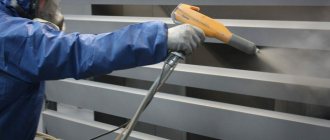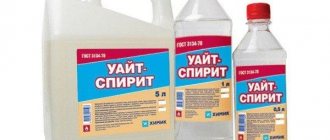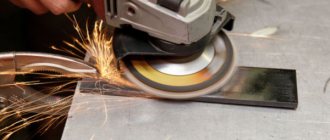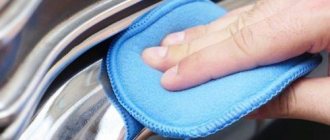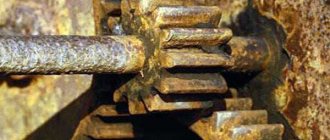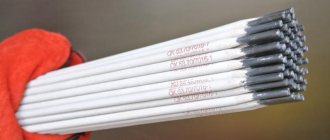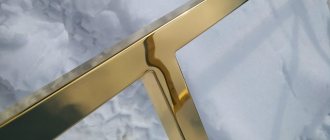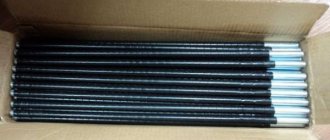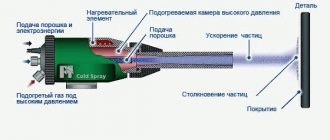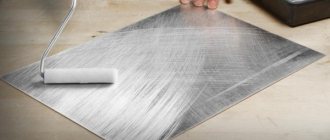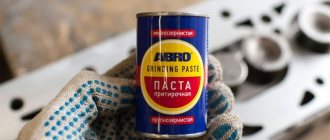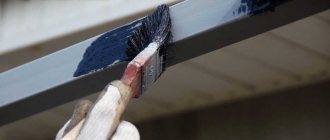In the article there is a video with satining of stainless steel. Satining or matting or polishing of stainless steel is carried out by applying marks to the metal. This creates a matte effect on the metal surface.
In this way you can polish and grind not only stainless steel, but also any metal. The only difference is in the hardness of the metal; you will spend more time and consumables on iron than on stainless steel, and you may not even notice the difference, only on large volumes. Brass and copper can be polished without grinding, but it is still better to use sandpaper, and cast iron generally does not lend itself well to polishing. Also, other metals are susceptible to exposure to the external environment, iron rusts, brass and copper darken. So other metals need to be chromed or varnished.
Subscribe to the newsletter so you don't miss new articles and drawings:
In one of the following articles I want to show the complete production of a fence from a 50x25mm profile pipe. The fence will be matte. Sanded using a satin finish.
In this article I will show you how to satin various fencing elements.
What is matting
Matting of stainless steel itself
is an increase in the surface roughness coefficient. The greater the roughness, the more matte the surface; The lower the roughness, the more glossy the stainless steel surface.
Matting of metal is in great demand in industry and is used mainly to obtain a higher quality and more beautiful appearance of products. Some methods of achieving a similar result also have additional advantages; the main advantage of matte polishing of stainless steel is the restoration of the anti-corrosion properties of the alloy steel.
Matting of stainless steel tanks carried out
Methods for matting stainless steel
Glass blasting
Glass blasting
- This is surface treatment with glass beads under pressure. It is carried out on the same principle as sandblasting or shot blasting technologies. During the processing process, the surface is bombarded with small abrasive particles directed by a stream of air under high pressure.
As a result of the collision of glass balls with the surface of stainless steel, cleaning occurs and the surface roughness increases - matting the metal surface.
Chemical matting (etching)
Read more about our pickling technology in the article “Pickling and passivation of stainless steel” in the “Services” section.
The main way to clean and dull the surface of stainless steel is by etching
. This method is used after heat treatment of the product, cold and hot plastic deformation, and also to remove weld marks. In addition to cleaning the surface, chemically matting stainless steel restores the passive layer, which protects the stainless alloy from the damaging effects of high temperatures.
As a result of the action of acids on the surface of stainless steel, the surface is cleaned, the alloying layer is restored and the roughness coefficient increases, which leads to chemical matting of the metal.
will perform matting (matt) stainless steel according to your order.
You also have the opportunity
to purchase consumables for matting
, such as liquids for etching stainless steel using the immersion method or similar consumables.
Powder composition for coloring
In everyday life, this method of applying paint on stainless steel cannot be used. The heat-resistant powder composition is applied with a spray gun. After its application, the stainless steel is placed in a chamber where the temperature is raised to 200 o C. A film is formed that is resistant to external influences. The film can be glossy, matte or imitate different surfaces. The applied layer will be even. The result will be a large selection of color shades. Only removable items can be painted in this way. The bulky product is not painted with powder material at the installation site. The new coating is not afraid of direct sunlight. The process is called waste-free. The material dries in 30 minutes.
The technological process itself has advantages:
- Economical consumption of dye, since it is applied in one layer.
- High adhesion is especially important for stainless steel.
- The remaining powder is not thrown away, but used for the next time.
- Painting is done quickly.
In everyday life, painting is also not carried out after which an oxide film is formed. Steel is processed using plasma at a low temperature. The process requires certain conditions to be met: the presence of oxygen in the atmosphere. Although the metal remains unchanged (matte and shiny), covered with an oxide film, it changes color.
Pros and cons of stainless steel matting technologies
The main advantages of glass blasting are:
- Hardening. It is one of the types of strengthening of metals and their alloys by plastic deformation taking place at a temperature below the recrystallization temperature.
- Matting and formation of an anti-reflective matte surface.
The main disadvantages of glass blasting include:
- Processing of welded stainless steel products and the formation of cold hardening in the area of welds. The main nuance is the formation of chromium carbide (Cr3C2) when the surface of stainless steel is heated during welding. This compound is released along the grain boundaries of the alloy and deprives the steel of its main property - corrosion resistance. The corrosion that occurs during the formation of chromium carbide is intercrystalline and is very dangerous, as it reduces the strength of the metal and makes it brittle. Carrying out glass blasting will inevitably lead to the formation of cold hardening, which, in turn, contributes to the “pressing” of chromium carbide formations into the metal.
- High cost of consumables and electricity.
Among the main advantages of chemical etching technology are:
- Restoring passivation on matte stainless steel.
- Uniform matting. Since chemical matting (etching) is carried out by immersion, the solution used in the baths completely envelops the product and evenly affects the surface of the stainless steel, giving it a much more uniform matte color than mechanical/glass blasting.
- No formation of hardening and complete cleaning of the surface from the formed oxides (discoloration) from the surface of the welds. Removing corrosion and other heavy contaminants.
The main disadvantages of chemical etching technology are:
- The use of aggressive acids and requirements for the room or baths where the technology is installed;
- The need for timely waste disposal.
Source
Brushed stainless steel
In the manufacture of individual metal parts and decorative items, bluing of stainless steel may be required. For this purpose, chemical and electrochemical methods and specialized solutions are used. Chemical treatment is possible with alkalis using special catalysts and acids. Thermal bluing is also used in ammonia, salt and other environments. The most common option involves processing metal products in solutions of metal salts.
How to make stainless steel matte
Stainless steel comes in different varieties. After all, it contains several different metals. The basis of stainless steel is iron, titanium, nickel, molybdenum, manganese, and this is not the entire list. Chromium, which is also present in its composition, helps this steel resist corrosion.
Polishing stainless steel: techniques and tools used
Polishing is an operation that relates to finishing when processing various surfaces. Polishing consists of sequentially removing layers of material in small volumes, using various methods and materials. This achieves a matte or mirror-like surface shine.
Among the many processes, mechanical, chemical, electrochemical and electrolyte-plasma have become the most widespread.
In addition to imparting an aesthetic appearance to the finished product, this type of processing can be determined by technological requirements for the surfaces of elements and their interaction with each other.
Stainless steel products are in most cases polished. The methods discussed here are suitable for a wide range of stainless steel grades. To select the optimal method, it is necessary to use reference literature and developed polishing flow charts.
Preparation of material
How to properly prepare a simple copper plating electrolyte
It is worth noting that electroplating with copper at home is difficult because the chemicals are not easy to find. Companies selling such products do not sell them without special documents. But you can do everything yourself.
It is possible to prepare electrolyte at home only if the recipe is strictly followed. The simplest electrolyte contains:
The finished solution has a bright blue color and no odor. Some sediment may be present. It is important to follow all safety precautions with chemical reagents, especially at home: protect your hands and eyes first. Clothes on which the solution could accidentally spill are best classified as summer clothes.
It is better to store such liquid in glass bottles or plastic canisters, and be sure to indicate the date of bottling and the name of the solution. Proper storage of components will save you from possible problems. Electrolyte preparation should take place in clean plastic or glass containers.
Preparing material for copper plating at home
Chemical copper plating is an alternative to the electrochemical method, but cannot always replace it. In this process, it is important to carefully prepare the part, completely eliminating scratches, dirt, chips, etc. In order to degrease an item, you can use both pure solvents and degreasing solutions.
However, there is no universal method - different types of metal are cleaned in different ways:
Stainless steel processing
There are many options for surface treatment of sheets. The first is matting of stainless steel. Different technologies are used:
- Finishing sandblasting and glass blasting (glass granulate). Necessary for removing relief that can hold dirt, traces of tarnish, and spot welding on the surface;
- electrolyte-plasma method;
- various pastes for steel surfaces.
Passivation of stainless steel is also used - a technology that allows you to restore the protective properties of the material and improve resistance to corrosion. The choice of solution depends on the composition of the material. If it has a high chromium content, nitric acid is used. For products with a large amount of nickel, a nitrogen solution with sodium bichromate is better suited.
One of the common processing methods is chemical etching of stainless steel. It is often used as a preparatory step for other techniques. There are several options - acidic, acidic with electrolyte, alkaline. Passivation can also be called one of the etching methods. If you are interested in such services, please contact.
Cleaning the hood
This is not an easy task. But quite doable. To prevent dirt and soap from staining the stove, it is better to cover it with newspapers or old towels.
To clean the hood, you can use a specialized product or prepare a solution yourself. You will need bicarbonate of soda, lemon juice and water. The product must be rubbed in carefully so as not to damage the surface. It is enough for the solution to remain on the hood for several minutes, after which it must be washed off with clean running water. Next, you need to polish the surface well with a dry cloth. After this procedure, the hood will shine like new.
How to make stainless steel soft?
Stainless steel comes in different varieties. After all, it contains several different metals. The basis of stainless steel is iron, titanium, nickel, molybdenum, manganese, and this is not the entire list. Chromium, which is also present in its composition, helps this steel resist corrosion.
What prevents steel from rusting
When chromium interacts with oxygen, a protective film is formed on the surface of stainless steel; it is this film that protects the alloy from exposure to aggressive environments.
The amount of chromium will determine the degree of corrosion resistance of steel.
For example, in the manufacture of refrigerators, an alloy with an average chromium content (10-17%) is used. But if the device is constantly in contact with water or is subjected to temperature loads, then an alloy with a high chromium content, up to 26%, is used. Such appliances include washing machines, dishwashers, sinks, hoods, cookers and kettles.
In order for the surface of the alloy to be beautiful and smooth, you need to polish the stainless steel. Nowadays, there are many companies whose specialization is this particular procedure; they put in order various products made from this alloy. But it turns out that you can polish stainless steel at home.
Of course, if you need better quality work, it is better to seek help from specialists. For example, a polished square stainless steel pipe will look much more impressive after factory processing than after home processing.
Any company that specializes in polishing will easily perform this procedure.
Electrochemical (galvanic) etching
To carry it out, it is necessary to perform a number of procedures.
Preparation of the solution . Prepare an aqueous solution of the acid chosen for etching. It is necessary to carefully calculate its percentage.
Surface preparation. It is necessary to perform degreasing using any method so that the protective varnish adheres well to the stainless steel. After processing, it is not recommended to touch the workpiece so as not to cause peeling of the varnish and, as a result, uneven surface treatment.
Creation of a protective layer . It is necessary to apply a protective layer to areas that do not need etching. In industry, special compounds are used for this, which can also be used for home processing (subject to safety precautions). You can also cook a protective varnish at home, consisting of tar and rosin dissolved in turpentine.
Etching . When carrying out electrochemical etching of stainless steel, the workpiece is lowered into a previously prepared solution, after which voltage is applied to the created electrical circuit. In this circuit, the anode is a workpiece with a connected positive electrode; any steel plate is used as a cathode.
The duration is determined by the type of part, carefully observing the condition of the workpiece, but not more than a few minutes. After this, turn off the voltage, remove the etched part from the solution and carefully neutralize the acid using reagents.
Cleaning stainless steel . Clean stainless steel from residual solutions using special means that do not affect the characteristics of the metal.
Homemade formulations differ from industrial substances in their reduced content of harmful chlorides. Pastes are made on the basis of nitric and hydrofluoric acid. This is a liquid, jelly-like, transparent substance that requires caution when used.
Before using the paste, the stainless alloy workpiece must be thoroughly cleaned and degreased. To apply the paste to stainless steel, special tools are used: plastic spatulas and brushes made of acid-resistant materials.
The holding time of the paste depends on the brand used; it is indicated in the instructions for the paste. Possible time interval – from 10 minutes. up to an hour. The paste is washed off with plenty of running water (taking precautions).
When working with large products, the large area of which makes applying pastes difficult, use the jet spraying method using etching sprays for processing stainless steel.
Technology of matting the surfaces of metal products
Matting of metals is one of the types of finishing of hardware. Matting technology aims to obtain a uniform matte and dull surface, that is, matting technology is aimed at improving the surface of the metal, just like electroplating. The technology of matting a metal surface involves one of the following methods of carrying out this operation: processing with rotating circles-brushes, using stampings, shot blasting or etching in solutions.
If the technology of matting hardware with rotating metal circles-brushes is used, the metal particles on the surface are flattened, filling small irregularities and pores, as a result of which the roughness is smoothed out and the metal surface becomes uniformly dull.
Brushes, the use of which involves matting technology, consist of a metal or wooden sleeve, several rows of moving bundles of wire are stuck into it. Brushes differ in types, sizes, and materials of their working (pile) part. The main indicators of brush quality are the material and diameter of the bristles, the density of the working part, the free length of the bristles, the diameter and width of the brush. The material for the working part of the brush is steel or copper wire with a diameter of 0.05 to 1.2 mm, natural or synthetic bristles, sea grass, cotton yarn, etc. The longer the bristles of the brush and the less dense the working part, the less intense manages to scrape off unevenness. The technology of matting metals involves the use of such brushes for finishing matting operations. There is no need to put strong pressure on the brushes, because this will wear out the ends of their bristles, the quality of the treated surface will deteriorate and labor productivity will decrease.
The technology of matting with mints is implemented by striking the mints with a hammer; on their working surface there is an engraved notch with intersecting strokes. The matting technology can also produce such a pattern on coins by driving a notch into the front part of the striker from a fine annealed file. Upon completion of the notching, the coins are hardened and tempered. When matting the metal, the hammer should be held with the index, thumb and middle fingers. The other 2 fingers on the hand lightly touch the surface of the workpiece, sliding along it. The coin is held with a slight tilt back, moving with rhythmic hammer blows on the metal surface.
